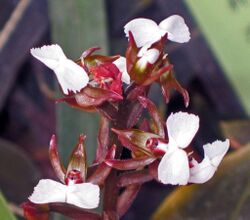Biology:Rhomboda
| Rhomboda | |
|---|---|

| |
| Rhomboda moulmeinensis | |
| Scientific classification | |
| Kingdom: | Plantae |
| Clade: | Tracheophytes |
| Clade: | Angiosperms |
| Clade: | Monocots |
| Order: | Asparagales |
| Family: | Orchidaceae |
| Subfamily: | Orchidoideae |
| Tribe: | Cranichideae |
| Subtribe: | Goodyerinae |
| Genus: | Rhomboda Lindl.[1] |
| Type species | |
| Rhomboda longifolia | |
Rhomboda, commonly known as velvet jewel orchids,[3] is a genus of about twenty species of flowering plants in the orchid family Orchidaceae. Plants in this genus are mostly terrestrial herbs with a fleshy, creeping rhizome and a loose rosette of green to maroon coloured leaves. Small resupinate or partly resupinate, dull coloured flowers are borne on a hairy flowering stem. The dorsal sepal and petals overlap and form a hood over the column and there is a deep pouch at the base of the labellum. They are found in tropical regions from northern India through Southeast Asia, China , Japan to Australia and some Pacific Islands.
Description
Orchids in the genus Rhomboda are usually terrestrial, perennial, deciduous, sympodial herbs with a creeping, fleshy, above-ground rhizome anchored to the ground by wiry roots. A few species are epiphytic. The leaves are spirally arranged around the stem with the upper leaves forming a loose rosette. They are dark green to maroon or brownish with a central white or red line. The flowers are resupinate or partly resupinate with the dorsal sepal and petals fused to form a hood over the column. The lateral sepals are similar to the dorsal sepal, free and often spreading. The labellum has a deep pouch near its base, a narrow middle section and often has a hooked tip.[3][4][2][5][6]
Taxonomy and naming
The genus Rhomboda was first formally described in 1857 by John Lindley and the description was published in Journal of the Linnean Society, Botany.[1][7] The name Rhomboda is derived from the Ancient Greek word rhombos meaning "a top",[8] referring to the shape of the calli on the labellum of the type specimen.[4]
Distribution
Orchids in the genus Rhomboda are native to Nepal, India, Sri Lanka, Bhutan, China, Myanmar, Thailand, Laos, Cambodia, Vietnam, Japan, the Philippines , New Guinea, New Caledonia, the Solomon Islands, Vanuatu and Queensland between the Daintree and Paluma.
Species list
The following is a list of species accepted by the World Checklist of Selected Plant Families as at August 2018:[1]
- Rhomboda abbreviata (Lindl.) Ormerod - Guangdong, Guangxi, Guizhou, Hainan, Assam, Myanmar, Nepal, Thailand
- Rhomboda alticola (Schltr.) Ormerod - New Guinea
- Rhomboda arunachalensis A.N.Rao - Arunachal Pradesh
- Rhomboda atrorubens (Schltr.) Ormerod - New Guinea, Bismarck Archipelago
- Rhomboda bantaengensis (J.J.Sm.) Ormerod - Sulawesi
- Rhomboda blackii (Ames) Ormerod - Mindanao
- Rhomboda cristata (Blume) Ormerod - Java, Philippines
- Rhomboda dennisii Ormerod - Vanuatu, Solomon Islands
- Rhomboda elbertii Ormerod - Sulawesi
- Rhomboda fanjingensis Ormerod - Guizhou
- Rhomboda kerintjiensis (J.J.Sm.) Ormerod - Sumatra
- Rhomboda lanceolata (Lindl.) Ormerod - Darjiling, Bhutan, Assam, Arunachal Pradesh, Myanmar, Vietnam, Peninsular Malaysia, Philippines, Sulawesi, Sumatra, New Guinea, Kyushu
- Rhomboda longifolia Lindl. - Sikkim
- Rhomboda minahassae (Schltr.) Ormerod - Sulawesi
- Rhomboda moulmeinensis (C.S.P.Parish & Rchb.f.) Ormerod - Guangxi, Guizhou, Sichuan, Tibet, Yunnan, Myanmar, Thailand
- Rhomboda pauciflora (Ridl.) Ormerod - Vietnam, Peninsular Malaysia, Sabah
- Rhomboda petelottii (Gagnep.) Ormerod - Vietnam
- Rhomboda polygonoides (F.Muell.) Ormerod - Queensland, New Guinea, Maluku, Solomon Islands, Bismarck Archipelago, New Caledonia
- Rhomboda pulchra (King & Pantl.) Ormerod & Av.Bhattacharjee
- Rhomboda tokioi (Fukuy.) Ormerod - Guangdong, Taiwan, Japan, Ryukyu Islands, Vietnam
- Rhomboda velutina (J.J.Sm.) Ormerod - Java, Lesser Sunda Islands
- Rhomboda wardii Ormerod - Myanmar
- Rhomboda yakusimensis (Masam.) Ormerod - Ryukyu Islands, Izu Islands, Kyushu
References
| Wikimedia Commons has media related to Rhomboda. |
- ↑ Jump up to: 1.0 1.1 1.2 "Rhomboda". World Checklist of Selected Plant Families (WCSP). Royal Botanic Gardens, Kew. http://wcsp.science.kew.org/namedetail.do?name_id=178241.
- ↑ Jump up to: 2.0 2.1 "Rhomboda". Centre for Australian National Biodiversity Research (CANBR), Australian Government. 2010. http://www.canbr.gov.au/cpbr/cd-keys/RFKOrchids/key/rfkorchids/Media/Html/genera/Rhomboda.htm.
- ↑ Jump up to: 3.0 3.1 Jones, David L. (2006). A complete guide to native orchids of Australia including the island territories. Frenchs Forest, N.S.W.: New Holland. p. 349. ISBN 1877069124.
- ↑ Jump up to: 4.0 4.1 Genera orchidacearum (Volume 3). Oxford University Press. 2003. pp. 142–145. ISBN 0198507119.
- ↑ "Rhomboda". Flora of China. http://www.efloras.org/florataxon.aspx?flora_id=2&taxon_id=128428. Retrieved 4 September 2018.
- ↑ "Genus Rhomboda". Orchids of New Guinea. http://www.orchidsnewguinea.com/orchid-information/genus/genuscode/56. Retrieved 4 September 2018.
- ↑ Lindley, John (1825). "The Orchidology of India". Journal of the Linnean Society, Botany 1: 181. https://www.biodiversitylibrary.org/item/8352#page/185/mode/1up. Retrieved 4 September 2018.
- ↑ Brown, Roland Wilbur (1956). The Composition of Scientific Words. Washington, D.C.: Smithsonian Institution Press. p. 227.
Wikidata ☰ Q9068840 entry
 |

